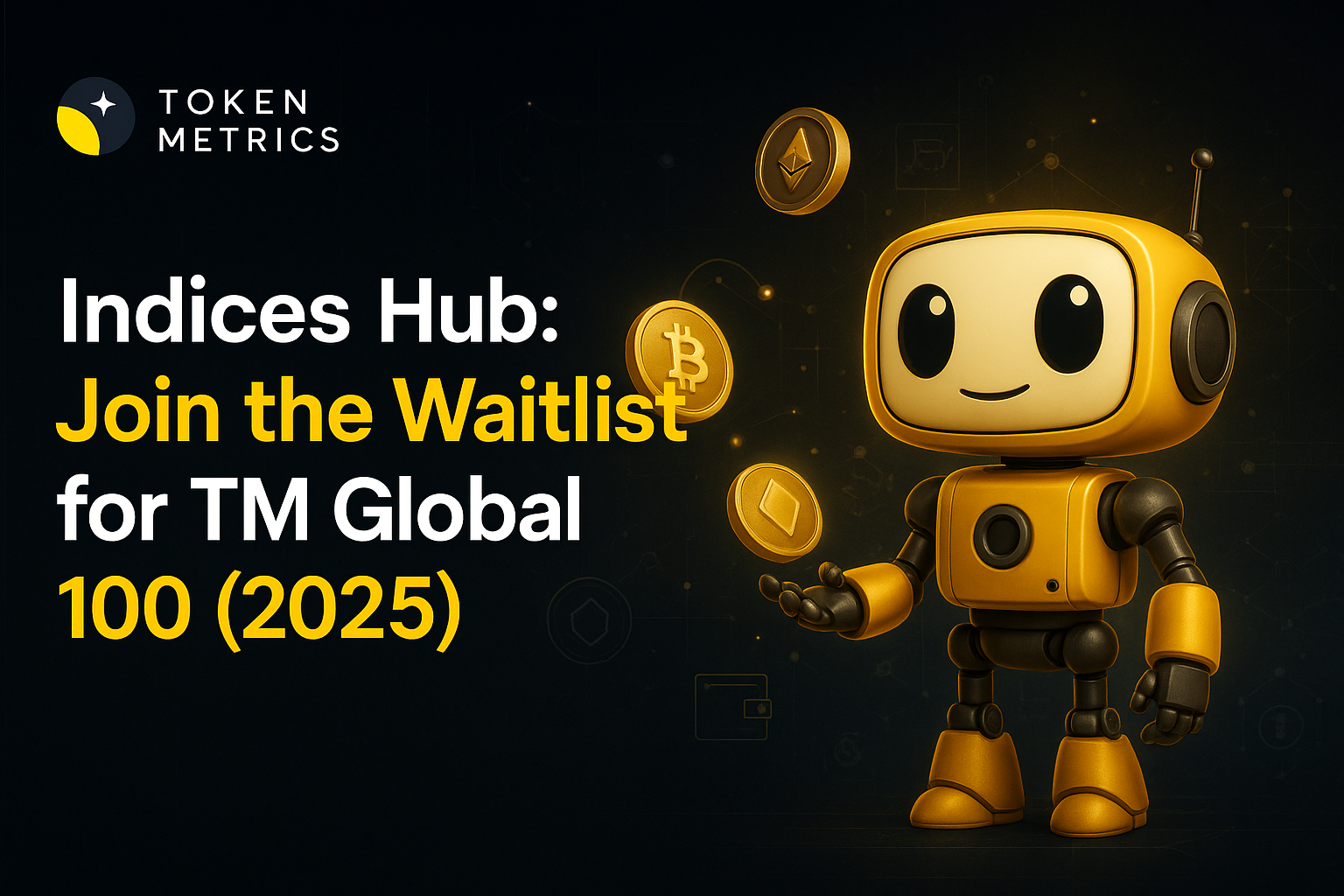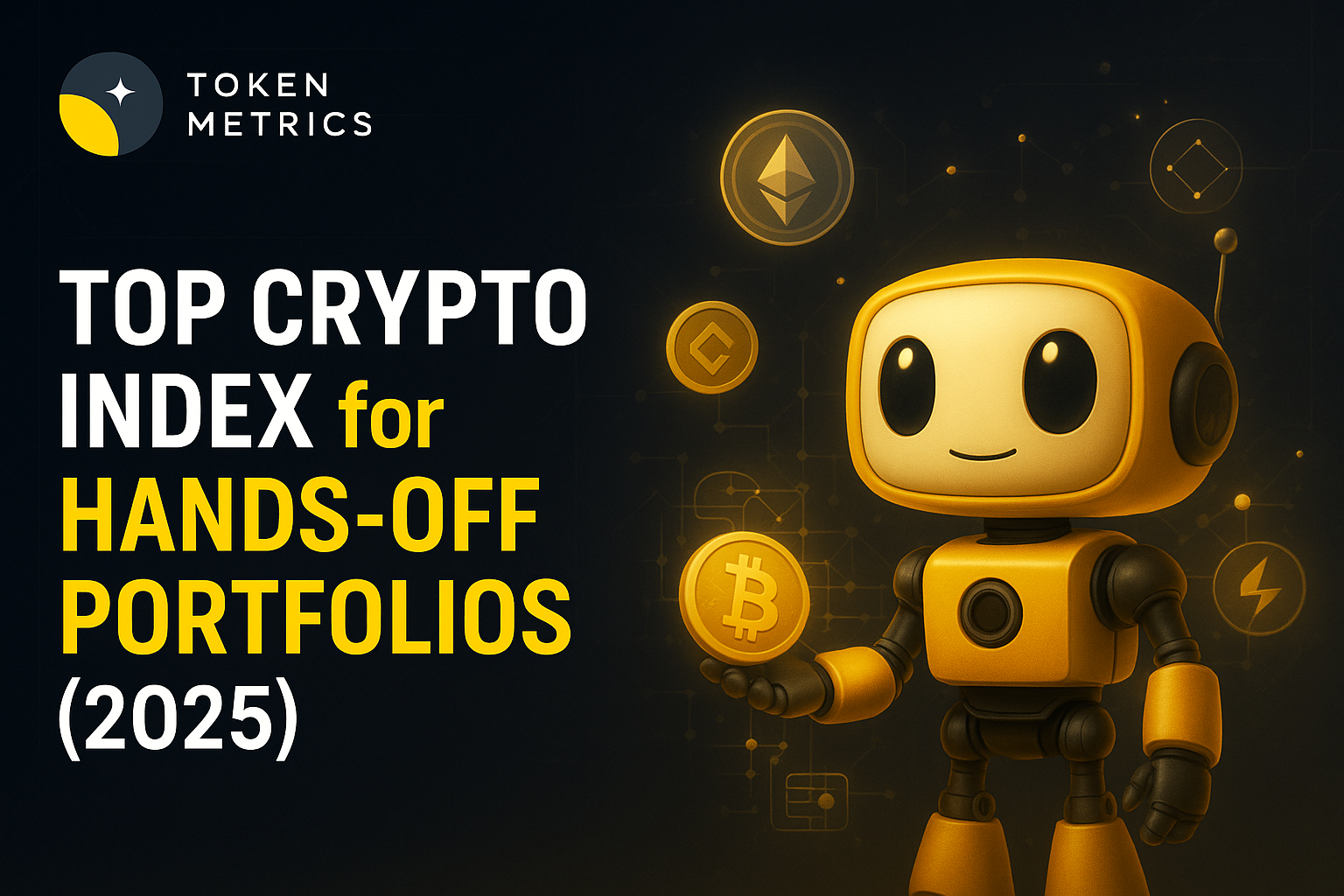Top Crypto Trading Platforms in 2025







%201.svg)
%201.svg)
Big news: We’re cranking up the heat on AI-driven crypto analytics with the launch of the Token Metrics API and our official SDK (Software Development Kit). This isn’t just an upgrade – it's a quantum leap, giving traders, hedge funds, developers, and institutions direct access to cutting-edge market intelligence, trading signals, and predictive analytics.
Crypto markets move fast, and having real-time, AI-powered insights can be the difference between catching the next big trend or getting left behind. Until now, traders and quants have been wrestling with scattered data, delayed reporting, and a lack of truly predictive analytics. Not anymore.
The Token Metrics API delivers 32+ high-performance endpoints packed with powerful AI-driven insights right into your lap, including:
Getting started with the Token Metrics API is simple:
At Token Metrics, we believe data should be decentralized, predictive, and actionable.
The Token Metrics API & SDK bring next-gen AI-powered crypto intelligence to anyone looking to trade smarter, build better, and stay ahead of the curve. With our official SDK, developers can plug these insights into their own trading bots, dashboards, and research tools – no need to reinvent the wheel.
%201.svg)
%201.svg)
If you want broad exposure to cryptocurrencies without constant chart monitoring, a top crypto index offers a streamlined way to participate in the market. Token Metrics provides innovative tools to help you understand and access such indices efficiently.
If you’re seeking an uncomplicated, rules-driven approach to crypto investing that adapts to market conditions, a top crypto index might be worth exploring. These indexes automate the process of capturing upside potential while managing risk during downturns, making crypto investing more accessible for a variety of investor profiles.
A crypto index is a systematic, rules-based collection of digital assets that reflects a specific universe—such as the top 100 cryptocurrencies by market capitalization. It relies on transparent methodologies and scheduled rebalancing to ensure that the composition remains aligned with market dynamics. These indexes aim to provide broad exposure while reducing the need for individual asset management.
Many modern crypto indexes incorporate regime switching mechanisms: during bullish periods, they hold top assets; during bear markets, they shift to stablecoins to mitigate losses. Weekly rebalancing updates the constituents based on current market rankings, and transparency tools such as strategy descriptions, gauges, and transaction logs allow users to verify holdings and changes in real-time.
To gain early exposure, follow these steps:
Consider your investment style:
It is a rules-based basket that tracks a defined universe of digital assets—such as the top 100 by market cap—using transparent methodology and scheduled rebalancing.
The index rebalances weekly, with regime switches occurring when market signals change, ensuring adaptability during different market cycles.
A proprietary market-regime signal triggers the transition, exiting token positions to stablecoins during bearish periods and re-entering when signals turn bullish.
At launch, the embedded wallet will support supported funding options based on your chain or wallet. USDC payout is available upon sale; further options may follow.
No. It’s an embedded, self-custodial smart wallet—giving you full control over your private keys and funds.
Estimated gas, platform fee, slippage, and minimum expected value are displayed before you confirm the transaction, providing full transparency.
Visit the Token Metrics Indices hub or the TM Global 100 page, tap “Join Waitlist,” and follow the instructions to register your interest and prepare for launch.
Crypto assets are highly volatile and can result in significant losses. Past performance does not guarantee future results. This content is for research and educational purposes only and not financial advice.
%201.svg)
%201.svg)
If you’ve tried to “own the market” in crypto, you’ve felt the pain: chasing listings, juggling wallets, and missing rebalances while prices move. A top 100 crypto index aims to fix that—giving you broad exposure when the market is bullish and standing down when it’s not. Token Metrics Global 100 is our rules-based version of that idea: it holds the top-100 by market cap in bull regimes, moves to stablecoins in bear regimes, and rebalances weekly. You can see every rule, every holding, and every rebalance—then buy the index in ~90 seconds with an embedded on-chain flow. → Join the waitlist to be first to trade TM Global 100.
The market keeps cycling. New leaders emerge quickly. A “set-and-forget” bag can fall behind, while manual baskets burn hours and rack up slippage. Search interest for crypto index, regime switching, and weekly rebalancing keeps growing because people want a simple, disciplined core that adapts.
A top 100 crypto index is a rules-based basket that tracks the largest 100 crypto assets by market cap, typically rebalanced on a schedule to keep weights aligned with the market. In 2025, that alone isn’t enough. You also need discipline for downtrends. Token Metrics adds a regime-switching layer to move to stablecoins during bear phases—so you can participate in upside and sit out major drawdowns with a consistent, rules-based approach.
Regime switching:
Weekly rebalancing:
Transparency:
You’ll always see what you own, how it changed, and why.
→ Join the waitlist to be first to trade TM Global 100.
A rules-based basket tracking the largest 100 assets by market cap, typically with scheduled rebalancing. Token Metrics Global 100 adds regime switching to stablecoins during bear markets.
Weekly. In addition, if the market signal flips, the entire portfolio may switch between tokens ↔ stablecoins outside the weekly cycle.
A proprietary market-regime signal. When it’s bearish, the index exits tokens to stablecoins and waits for a bullish re-entry signal.
On launch, funding options surface based on your connected wallet and supported chains. USDC payouts are supported when selling.
The embedded wallet is self-custodial—you control your funds.
Before you confirm a buy, you’ll see estimated gas, platform fee, max slippage, and minimum expected value—all up front.
Go to the TM Global 100 page or the Indices hub and click Join Waitlist. You’ll get notified at launch with simple steps to buy.
Crypto is volatile and can lose value. Past performance is not indicative of future results. This article is for research/education, not financial advice.
A top 100 crypto index is the simplest path to broad market exposure—if it’s built with discipline. Token Metrics Global 100 combines transparent rules, weekly rebalancing, and a regime switch to stablecoins, so you can focus on your strategy while the core maintains itself. Now’s the time to claim early access. → Join the waitlist to be first to trade TM Global 100.
%201.svg)
%201.svg)
After a whipsaw year, many investors are asking how to stay exposed to crypto’s upside without riding every drawdown. Rules-based crypto indexing is a simple, disciplined answer: follow a transparent set of rules rather than gut feelings. The Token Metrics Global 100 puts this into practice—own the top-100 in bullish regimes, rotate to stablecoins in bearish regimes, and rebalance weekly. On top of that, you can see what you own in real time with a Holdings Treemap, Table, and Transactions Log. Less second-guessing, more process.
→ Join the waitlist to be first to trade TM Global 100.
In a volatile cycle, emotion creeps in: chasing winners late, cutting losers early, or missing re-entry after fear. Rules-based crypto indexing applies consistent criteria—constituent selection, weighting, and rebalancing—so you don’t have to improvise in stress.
For readers comparing crypto index options, think of it as a codified playbook. A rules-based crypto index is a methodology-driven basket that follows predefined signals (e.g., market regime) and maintenance schedules (e.g., weekly rebalancing), aiming for repeatable behavior across cycles.
Rules-based crypto indexing is a systematic approach that tracks a defined universe (e.g., top-100 by market cap) and maintains it on a fixed cadence, with explicit rules for when to hold tokens and when to de-risk into stablecoins.
What you’ll see on launch: Price tile, “tokens: 100,” “rebalances weekly,” and a fast ~90-second Buy flow with fee/slippage previews.
See the strategy and rules. (TM Global 100 strategy)
→ Join the waitlist to be first to trade TM Global 100.
A methodology-driven basket that follows predefined rules for asset selection, weighting, and maintenance. In TM Global 100, that means top-100 exposure in bullish regimes and stablecoins in bearish regimes, with weekly rebalancing and full transparency.
Weekly. This cadence refreshes constituents and weights to align with current market-cap rankings; separate regime switches can move between tokens and stablecoins.
A documented market signal. When it turns bearish, the index exits to stablecoins; when bullish resumes, it re-enters the top-100 basket.
Funding options will surface based on your connected wallet and supported rails. USDC settlement on sells is supported; fiat on-ramps may be added over time.
No. The embedded wallet is self-custodial—you control your keys and assets.
Before confirming a trade, you’ll see estimated gas, platform fee, max slippage, and min expected value—so you can proceed with clarity.
Go to the Indices hub, open TM Global 100, and enter your email. You’ll receive a launch-day link to buy.
Crypto is volatile and can lose value. Past performance is not indicative of future results. This article is for research/education, not financial advice.
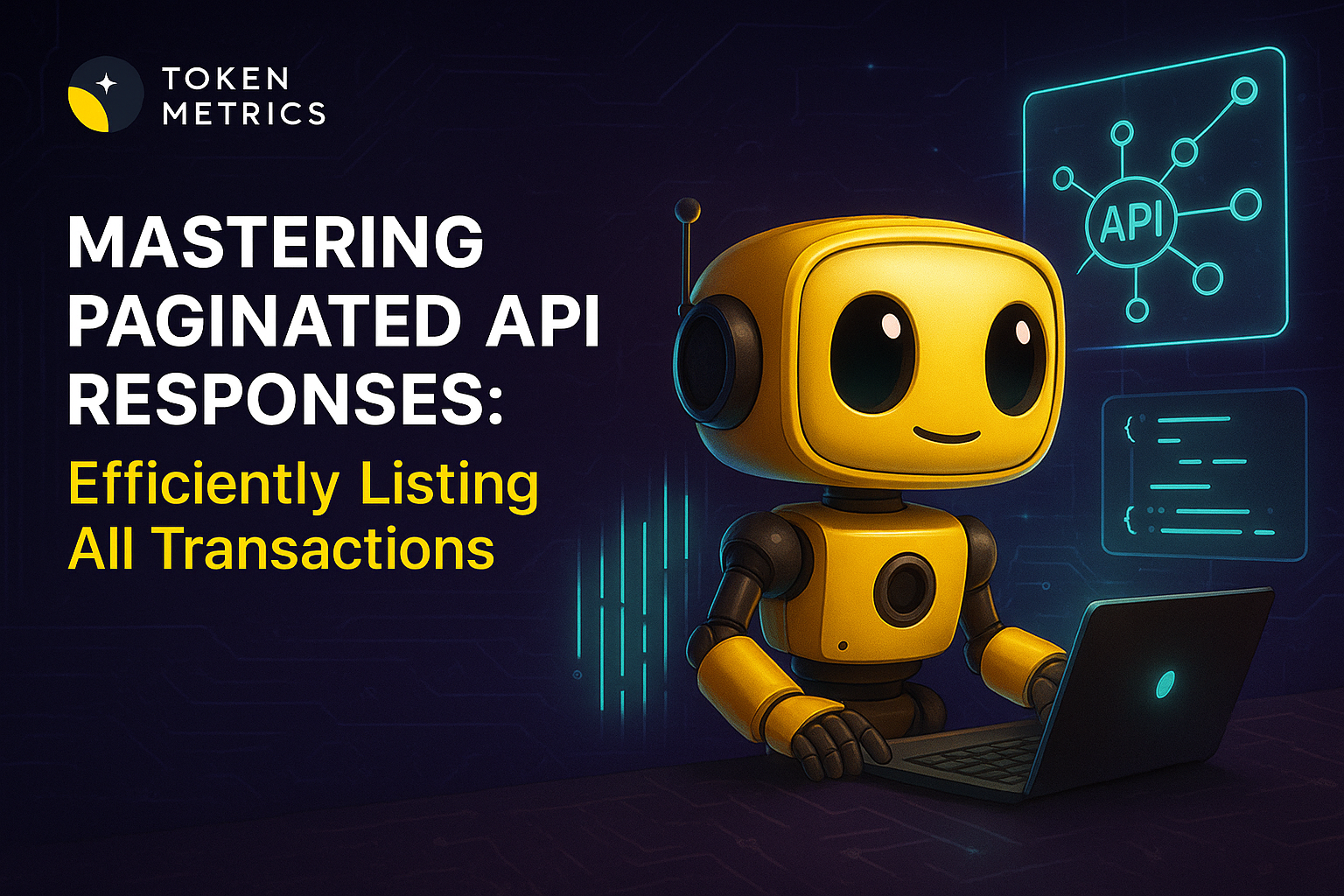
%201.svg)
%201.svg)
Managing large volumes of blockchain transaction data is a common challenge for developers building crypto dashboards, on-chain analytics tools, or AI applications. Most APIs limit responses to prevent server overload, making pagination the default when listing all transactions. But how can you reliably and efficiently gather complete transaction histories? Let’s dive into proven strategies for handling paginated API responses.
APIs often implement pagination to break up large datasets—such as transaction histories—into manageable portions. When requesting transaction data, instead of receiving thousands of records in one call (which could strain bandwidth or lead to timeouts), the API returns a subset (a "page") and instructions for fetching subsequent pages.
Each method affects performance, reliability, and implementation details. Understanding which your API uses is the first step to robust transaction retrieval.
Every API is unique—some allow only cursor-based access, while others support limit/offset or even page numbering. Choosing the right approach hinges on your project’s requirements and the API provider’s documentation. For crypto transaction logs or on-chain data:
For example, the Token Metrics API leverages pagination to ensure large data requests (such as all transactions for a wallet) remain consistent and performant.
To list all transactions efficiently, adhere to these best practices:
Below is a generic pseudocode example for cursor-based pagination:
results = []
cursor = None
while True:
response = api.get_transactions(cursor=cursor)
results.extend(response['transactions'])
if not response['next_cursor']:
break
cursor = response['next_cursor']
This approach ensures completeness and flexibility, even for large or frequently-updated transaction lists.
For large portfolios, trading bots, or AI agents analyzing multi-chain transactions, efficiently handling paginated API responses is critical. Considerations include:
When fetching transaction data, always practice security hygiene:
Systematically checking for data consistency between pages helps ensure you don’t miss or double-count transactions—a key concern for compliance and reporting analytics.
Build Smarter Crypto Apps & AI Agents with Token Metrics
Token Metrics provides real-time prices, trading signals, and on-chain insights all from one powerful API. Grab a Free API Key
Pagination is the process of breaking up a large dataset returned by an API into smaller segments, called pages. This practice prevents bandwidth issues and server overload, improving response times and reliability when dealing with extensive data sets such as blockchain transactions.
Cursor-based pagination is typically best for live or evolving datasets like blockchain transactions, as it’s less prone to data inconsistency and works well with rapid updates. However, always follow your chosen API’s recommendations for optimal performance.
Always implement data de-duplication by tracking unique transaction IDs. Carefully handle cursors or offsets, and consider double-checking against expected transaction counts or hashes for reliability.
This depends on the API's capabilities. Some APIs allow multi-address querying, while others require paginated requests per address. When retrieving multiple lists in parallel, monitor rate limits and system memory usage.
Efficient handling of paginated responses ensures complete, timely transaction histories—empowering AI-driven analytics tools to perform advanced analysis, detect patterns, and automate compliance tasks without missing critical data.
This blog post is for informational and educational purposes only. Nothing herein constitutes investment advice or an offer to buy or sell any asset. Please consult relevant documentation and a qualified professional before building production systems.
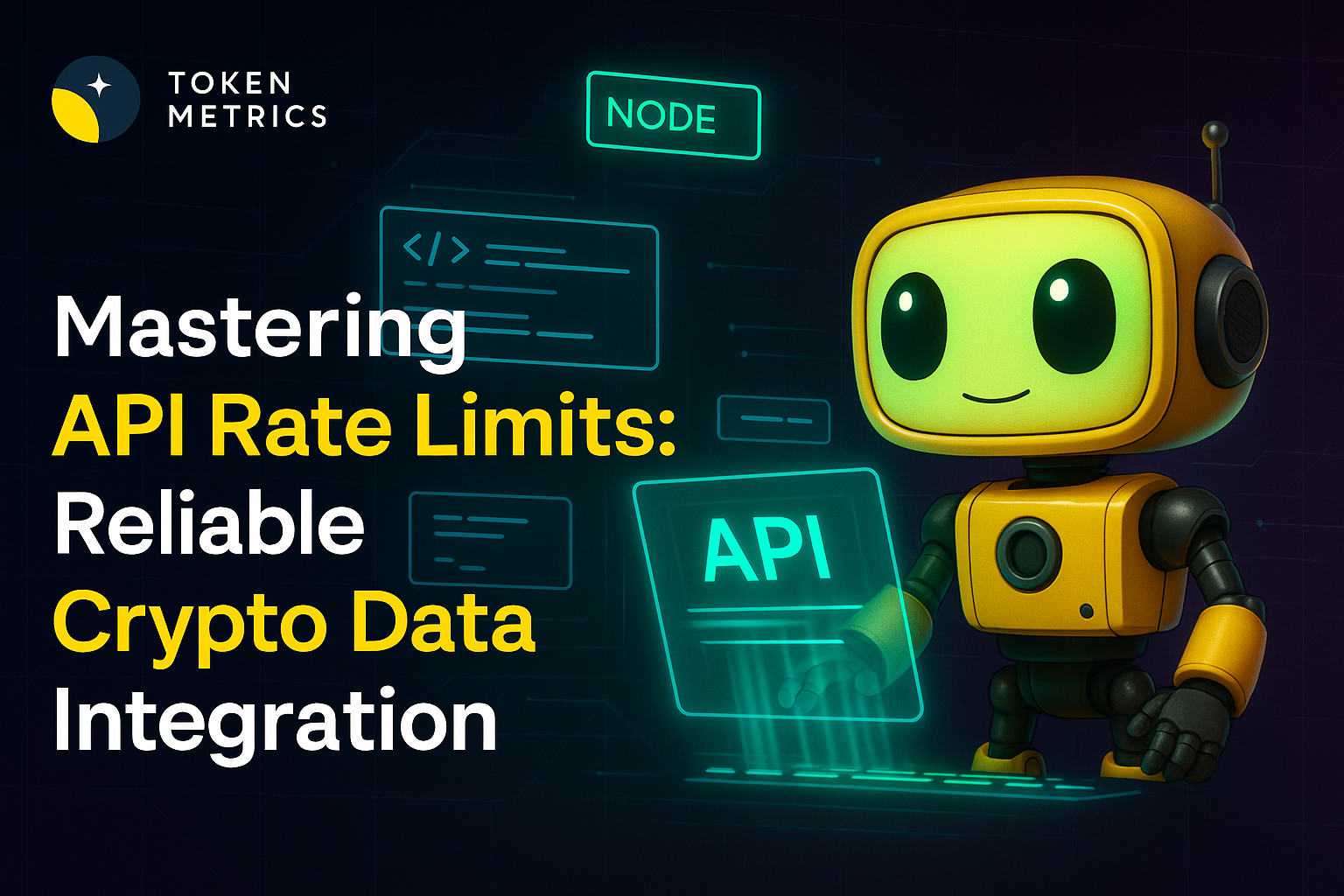
%201.svg)
%201.svg)
APIs are the backbone of most crypto applications, delivering vital real-time market prices, on-chain analytics, and network signals. Yet, while integrating a crypto data endpoint is powerful, developers quickly discover a common pain point: API rate limits. Mishandling these constraints can cause data gaps, failed requests, or even temporary bans—potentially compromising user experience or the accuracy of your analytics. Understanding how to manage API rate limits effectively ensures stable, scalable access to critical blockchain information.
API rate limits are enforced restrictions on how many requests a client can send to an endpoint within a defined period—such as 60 requests per minute or 1,000 per day. Crypto data providers implement these limits to maintain their infrastructure stability, prevent abuse, and ensure fair resource allocation for all clients. The most common rate-limiting strategies include:
Unintentional breaches—like a runaway script or a poorly timed batch request—will result in HTTP 429 errors (“Too Many Requests”), potentially leading to temporary blocks. Therefore, proactively understanding rate limits is crucial for both robust integrations and courteous API consumption.
When your app or research tool interacts with a crypto data API, receiving a rate-limit error is an opportunity to optimize, not a dead end. Most reputable API providers, including those specializing in crypto, supplement response headers with usage limits and reset timers. Key signals to watch for:
X-RateLimit-Limit, X-RateLimit-Remaining, and X-RateLimit-Reset. These values tell you your total quota, remaining requests, and when you can send requests again.Building logic into your client to surface or log these errors is essential. This helps in troubleshooting, performance monitoring, and future-proofing your systems as API usage scales.
Efficient handling of API rate limits is key for building dependable crypto apps, trading dashboards, and automated research agents. Here are recommended strategies:
X-RateLimit-Reset time, or show cached info with a ‘refresh’ indicator.These techniques not only ensure consistent access but also demonstrate good API citizenship, which can be crucial if you later negotiate higher access tiers or custom SLAs with a provider.
Providers vary widely in their rate limit policies—public/free APIs typically impose strict quotas, while premium plans offer greater flexibility. When selecting an API for your crypto project, assess:
Regulatory and operational needs can also influence choice—some institutional settings require SLAs or security controls only available on enterprise tiers.
The rise of AI agents and automated research scripts has made dynamic API rate-limit management even more critical. Advanced systems can:
Solutions like Token Metrics combine robust crypto APIs with AI-driven research—offering developers programmable access and insights while simplifying best-practice integration and rate management.
Build Smarter Crypto Apps & AI Agents with Token Metrics
Token Metrics provides real-time prices, trading signals, and on-chain insights all from one powerful API. Grab a Free API Key
If you consistently exceed rate limits, you'll likely receive 429 errors, experience dropped requests, and risk a temporary or permanent ban. Responsible handling is essential for reliable data access.
Attempting to circumvent limits by creating many accounts or cycling IPs is discouraged and may violate API terms of use. It's better to work with providers for a proper upgrade or optimization strategy.
Popular HTTP libraries like Axios (JavaScript), requests (Python), and HTTPX have built-in or community-supported retry/backoff plugins. Check your API ecosystem for recommended middlewares or SDKs supporting rate-limiting logic.
Each provider implements unique quotas: some limit based on IP, API key, or endpoint type, and some support higher throughput via premium plans or batch querying. Always review documentation for specifics.
Yes. Many crypto API services offer tailored plans or enterprise integrations with higher quotas. Proactively communicating your use case helps unlock better terms and ensures ongoing support.
This content is for educational and informational purposes only. It does not constitute investment advice, recommendation, or an offer to buy or sell any financial instrument. Use all APIs and tools in accordance with their terms and applicable regulations.
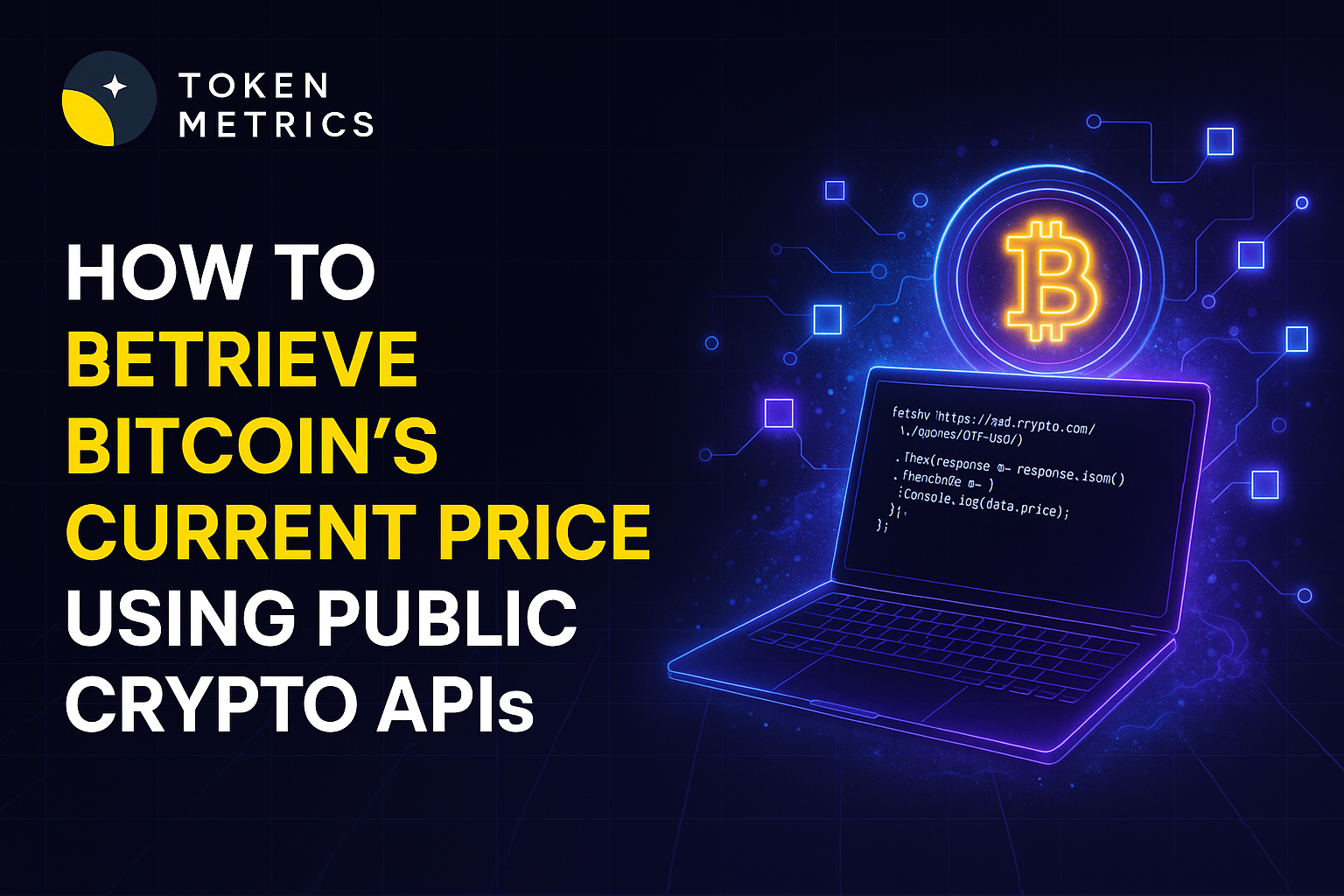
%201.svg)
%201.svg)
Whether you're building a crypto dashboard, conducting blockchain research, or creating an automated trading bot, access to real-time Bitcoin pricing is essential. But how do developers and data analysts retrieve the current price of Bitcoin from a public crypto API—and what are the key considerations when choosing an API for this purpose?
Crypto APIs—or Application Programming Interfaces—are structured gateways that let apps, bots, or websites communicate seamlessly with live crypto data sources. Instead of manually visiting exchanges or aggregators, an API call instantly delivers Bitcoin's current price in a standardized, machine-readable format. This capability underpins everything from price tickers to advanced algorithmic and AI-driven research tools.
Several types of organizations offer public crypto APIs, including:
Public APIs generally support unauthenticated (no login) endpoints for basic pricing, though many now require an API key for higher request rates and advanced data. Whether you’re a beginner or building a sophisticated AI agent, choosing the right crypto API—and querying it appropriately—is the foundational step.
The most straightforward way to retrieve Bitcoin's current price is to query a reputable crypto API from your application or terminal. Here’s a typical workflow:
https://api.coingecko.com/api/v3/simple/price?ids=bitcoin&vs_currencies=usd{ "bitcoin": { "usd": 43000 } }For more advanced needs, consider APIs offering historical pricing, volume data, or exchange-specific quotes, and always respect each provider’s usage policy.
Let’s look at how you might programmatically retrieve Bitcoin price data using Python and JavaScript. These examples use the free CoinGecko public endpoint, but principles are similar for other providers (including Token Metrics). Remember: Always insert your API key if required and consult the provider's documentation for up-to-date endpoints.
import requests
response = requests.get('https://api.coingecko.com/api/v3/simple/price?ids=bitcoin&vs_currencies=usd')
data = response.json()
print('Bitcoin price in USD:', data['bitcoin']['usd'])fetch('https://api.coingecko.com/api/v3/simple/price?ids=bitcoin&vs_currencies=usd')
.then(res => res.json())
.then(data => console.log('Bitcoin price in USD:', data.bitcoin.usd));For APIs requiring an API key, you typically add it via a header or as part of the URL (e.g., ?apikey=YOUR_API_KEY). Always treat keys securely and avoid sharing them in public code repositories.
Not all crypto APIs are equal: coverage, latency, historical data availability, and advanced analytics vary widely. Here are key factors to evaluate:
For enterprise or analytics-focused use cases, APIs like Token Metrics add value through comprehensive data sets, trading signals, and AI-powered insights, enabling deeper quantitative or on-chain research workflows.
Modern crypto research isn’t just about fetching a price—it’s about contextualizing that price within broader trends. AI and machine learning models, including those powering platforms like Token Metrics, ingest live price feeds, on-chain metrics, social sentiment, and more to provide actionable analytics and deeper market understanding.
For developers and researchers, integrating public crypto price APIs is often the first step in powering:
Choosing an API that delivers not only price, but also analytical data, can accelerate both research and application development.
Build Smarter Crypto Apps & AI Agents with Token Metrics
Token Metrics provides real-time prices, trading signals, and on-chain insights all from one powerful API. Grab a Free API Key
A public crypto API is an interface provided by exchanges or data aggregators that allows users to access cryptocurrency data—such as price, volume, and other metrics—without requiring private access or fees. Some APIs may still require free registration for an API key.
This depends on the provider. Leading APIs typically offer real-time or near real-time data (updated every second), but some aggregate or free APIs may introduce short delays. Always check the documentation for specifics on data freshness.
Yes. Almost all public APIs have rate limits—typically restricting the number of requests per minute or per day. These are put in place to prevent abuse and ensure fair access for all users. Higher limits may be available with paid plans or API keys.
This depends on the API’s terms of service. While many offer free public endpoints, commercial usage may be subject to tighter limits or require a paid plan. Always review the provider’s terms, especially for high-frequency or enterprise use.
Public APIs themselves are generally secure when accessed over HTTPS. However, always protect your API keys, follow provider best practices, and avoid exposing sensitive credentials in public code repositories or front-end codebases.
This article is for informational purposes only. It does not constitute financial advice, recommendations, or endorsements. Always conduct independent research and comply with all applicable laws and API usage terms before integrating third-party data sources.
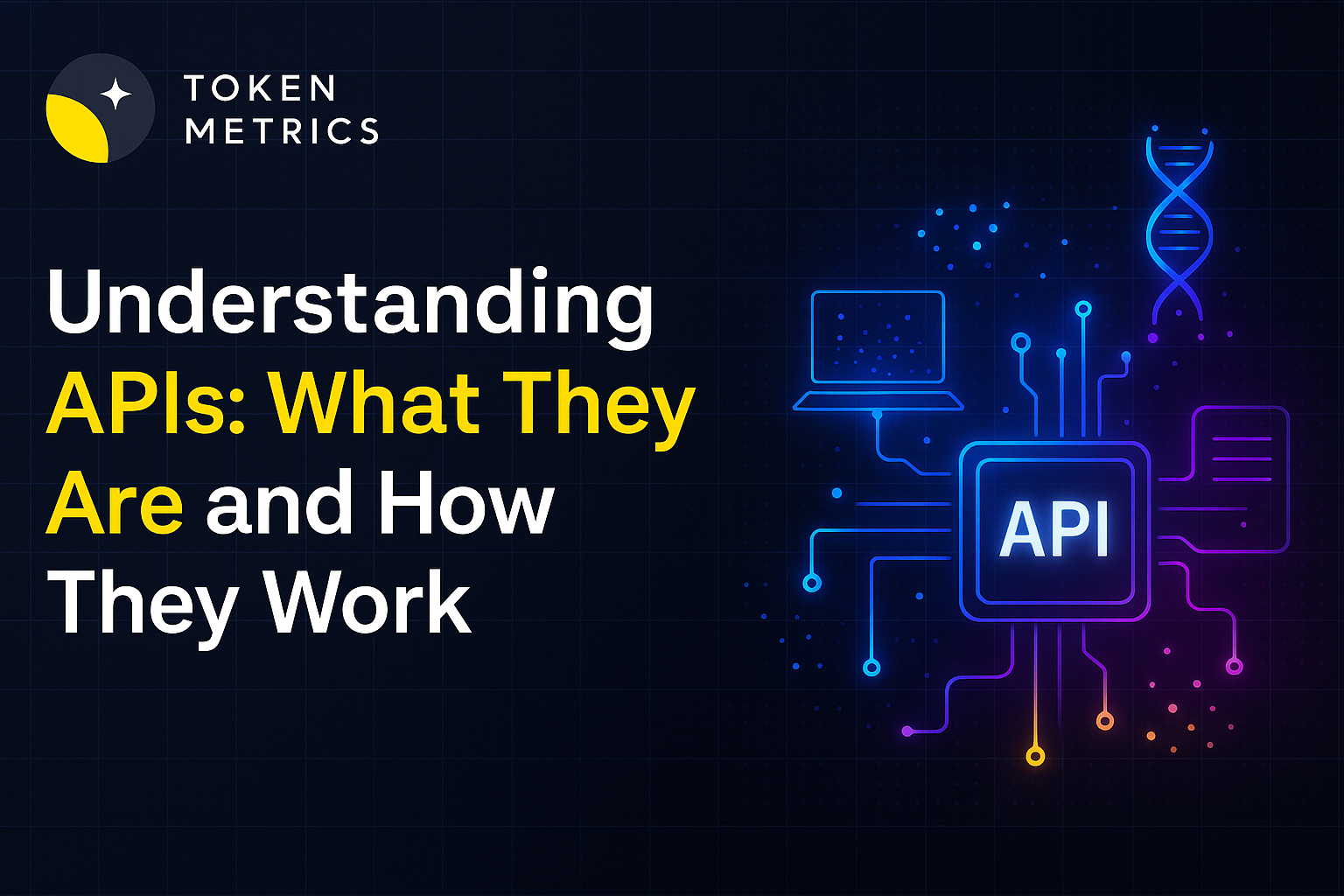
%201.svg)
%201.svg)
In the digital age, applications constantly interact with each other—whether it's your weather app pulling data from a meteorological server, or a crypto portfolio tracker fetching blockchain prices. The hidden force behind most of these interactions? APIs.
This blog post explores what an API is, how it works, and why APIs are so critical to modern software, including use in crypto and blockchain technologies.
API stands for Application Programming Interface. It acts as a bridge that enables two separate software systems to communicate and share data. Much like a waiter taking your order and delivering food between you and the kitchen, an API relays requests and returns the appropriate responses.
Developers use APIs to simplify the building of software applications. Rather than writing code from scratch, APIs allow developers to pull in data, execute tasks, or access services provided by another app or platform.
APIs operate through a series of requests and responses. The client (usually the application or user interface) sends a request to the server (which hosts the API). The API then handles this request, processes it based on pre-defined rules, and returns a response.
Here’s a simplified breakdown of the process:
Most modern APIs are RESTful (Representational State Transfer) and operate via HTTP protocols. These APIs are platform-agnostic and highly scalable, making them suitable for both web and mobile applications.
APIs are fundamental to the crypto ecosystem because they allow developers to:
Build Smarter Crypto Apps & AI Agents in Minutes, Not Months
Real-time prices, trading signals, and on-chain insights all from one powerful API. Grab a Free API Key
APIs vary based on their purpose and accessibility. It's important to understand the distinctions when designing or integrating them.
In the crypto world, partner APIs are often provided by exchanges, while open APIs are commonly seen on market data aggregator platforms.
Given that APIs provide entry points into systems, security is a top priority. Common best practices include:
Enterprises also use API gateways and management layers to track usage, apply governance policies, and scale efficiently.
The crypto industry is teeming with API-driven applications. Here are a few impactful examples:
Whether for DeFi apps, on-chain research, or Web3 gaming—APIs provide the infrastructure for scaling innovation.
A REST API (Representational State Transfer) is an architectural style that uses HTTP methods (GET, POST, PUT, DELETE) to facilitate communication between systems. It's known for being lightweight, stateless, and scalable.
Trading bots use API integrations to access live market data, monitor trade signals, and execute trades automatically on exchanges based on pre-programmed logic.
APIs can be secure if built with strong authentication, encryption, and rate limiting. However, poor implementation or public exposure without proper security layers can introduce vulnerabilities.
Yes. Many platforms like Token Metrics API offer public APIs to developers. These allow you to access real-time data and integrate core functionalities into your app.
Most modern APIs return data in JSON format due to its readability and ease of use. Some also offer XML or CSV for legacy systems.
This blog post is intended for educational purposes only. It does not constitute investment advice, trading guidance, or an endorsement of any financial instruments. Users should conduct their own due diligence and consult with professionals before making any financial decisions.

%201.svg)
%201.svg)
In today's digital asset ecosystem, Application Programming Interfaces, or APIs, are the unsung heroes enabling everything from cryptocurrency wallets to trading bots. Whether you're a developer building for Web3 or a curious user interested in how your exchange functions, understanding how crypto APIs work is essential
A crypto API is a set of programming instructions and standards that allow software applications to communicate with cryptocurrency services. These services may include wallet functions, price feeds, trading engines, exchange platforms, and blockchain networks. By using a crypto API, developers can automate access to real-time market data or execute trades on behalf of users without manually interacting with each platform.
For instance, the Token Metrics API provides structured access to cryptocurrency ratings, analytics, and other data to help teams build intelligent applications.
There are several categories of APIs in the cryptocurrency landscape, each with different capabilities and use cases:
At their core, crypto APIs operate over internet protocols—typically HTTPS—and return data in JSON or XML formats. When an application makes a request to an API endpoint (a specific URL), the server processes the request, fetches the corresponding data or action, and sends a response back.
For example, a crypto wallet app might call an API endpoint like /v1/account/balance to check a user’s holdings. To ensure security and authorization, many APIs require API keys or OAuth tokens for access. Rate limits are also enforced to prevent server overload.
Behind the scenes, these APIs interface with various backend systems—blockchains, trading engines, or databases—to fulfill each request in real time or near real time.
Crypto APIs are used across a broad spectrum of applications:
APIs dramatically reduce time-to-market for developers while enhancing user experience and application efficiency.
When integrating a crypto API, consider the following factors:
Platforms like the Token Metrics API provide both comprehensive documentation and reliability for developers building AI-powered solutions in crypto.
Some of the most powerful crypto APIs now incorporate artificial intelligence and machine learning features. For example, the Token Metrics API facilitates access to predictive models, coin grades, and AI-based price forecasts.
By embedding these tools into custom apps, users can programmatically tap into advanced analytics, helping refine research workflows and support technical or fundamental analysis. Although these outputs can guide decisions, they should be viewed in a broader context instead of relying exclusively on model predictions.
Crypto APIs are critical infrastructure for the entire digital asset industry. From data retrieval and trading automation to blockchain integration and AI-driven analytics, these tools offer immense utility for developers, analysts, and businesses alike. Platforms such as Token Metrics provide not only in-depth crypto research but also API access to empower intelligent applications built on real-time market insights. By understanding how crypto APIs work, users and developers can better navigate the rapidly evolving Web3 landscape.
This article is for informational and educational purposes only. It does not constitute financial, investment, or technical advice. Always conduct your own research and consult professional advisors before making any decisions.
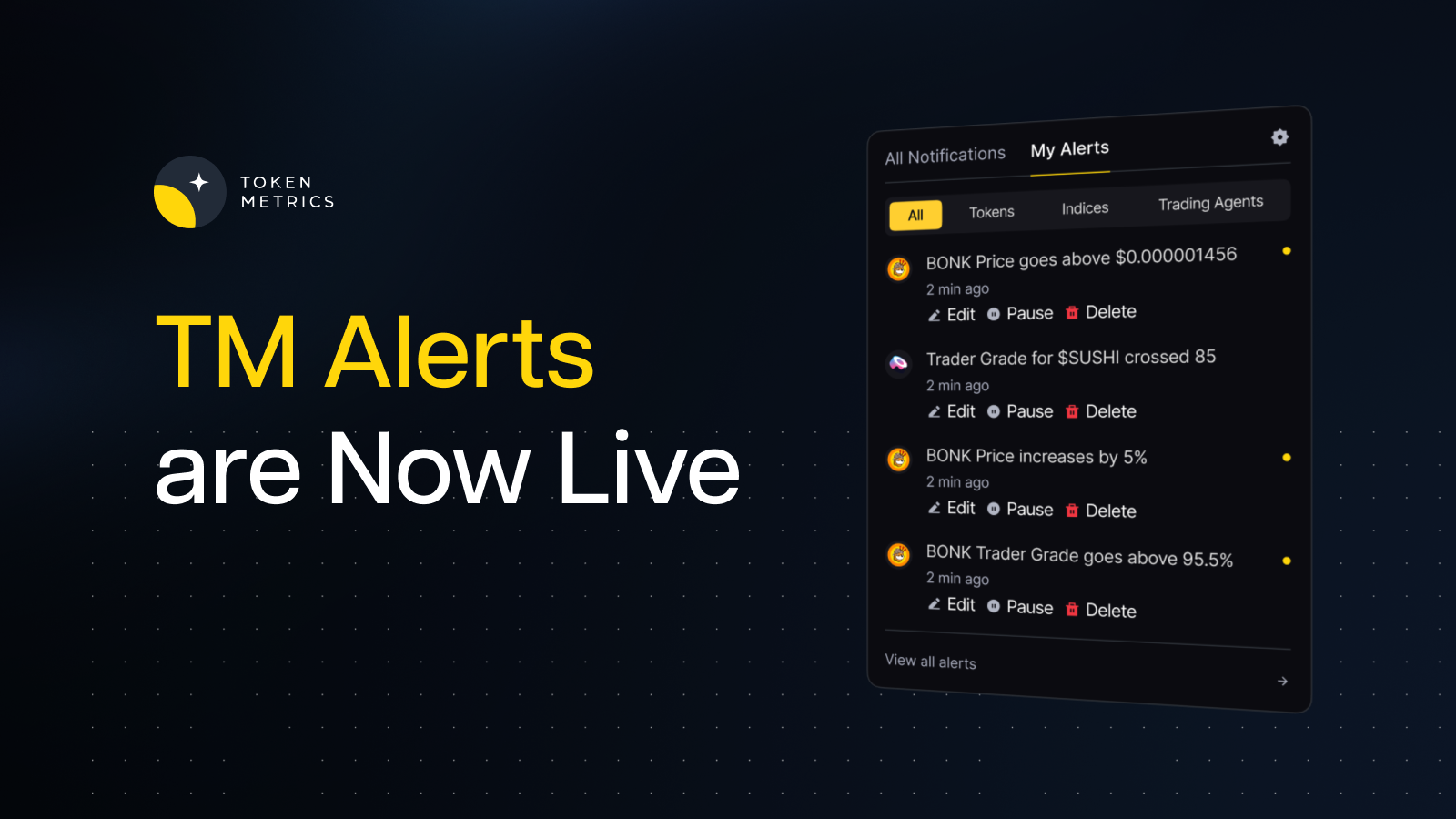
%201.svg)
%201.svg)
The cryptocurrency market operates on a simple, unforgiving principle: timing is everything. While traditional markets sleep, crypto never does. A single tweet, a regulatory announcement, or an AI signal flip can trigger massive price movements within minutes. For most traders, this creates an impossible dilemma – how do you capture every opportunity without becoming a prisoner to your screen?
Today, we're solving that problem forever.
Token Metrics Alerts represents the culmination of years of development and trader feedback. We've built the most sophisticated crypto alert system ever created, designed specifically for the unique challenges of cryptocurrency trading. This isn't just another notification tool – it's your personal market intelligence system.
The core philosophy behind Token Metrics Alerts is simple: empower traders with precise, actionable information delivered exactly when and how they need it. No more, no less.
At the heart of our alert system lies advanced artificial intelligence that continuously analyzes market conditions, price patterns, and trading signals across thousands of cryptocurrencies. When our AI algorithms detect a significant shift – whether bullish or bearish – you're notified instantly.
This AI-driven approach transforms how you interact with market data. Instead of interpreting charts and signals manually, you receive clear, actionable alerts based on sophisticated analysis that would take hours to perform yourself. The AI doesn't sleep, doesn't get emotional, and doesn't miss patterns that human eyes might overlook.
Our AI monitoring includes sentiment analysis, technical pattern recognition, volume analysis, and correlation tracking across multiple timeframes. When these systems converge on a significant signal, that's when you get alerted. It's like having a team of expert analysts working around the clock, exclusively for you.
Token Metrics Alerts recognizes that no two traders are identical. Day traders need different information than long-term holders. Swing traders have different requirements than scalpers. That's why we've built unprecedented customization into every aspect of the alert system.
You can set price movement alerts for any percentage change, whether you want to know about 5% moves or 50% pumps. Custom triggers allow you to monitor specific price levels, support and resistance breaks, or volume spikes. The system adapts to your trading strategy, not the other way around.
The best alert in the world is useless if you don't receive it. Token Metrics Alerts delivers notifications through five distinct channels, each optimized for different scenarios and preferences.
Email alerts provide detailed information perfect for analysis and record-keeping. Telegram integration offers lightning-fast mobile notifications that cut through the noise of other apps. Slack integration brings trading alerts directly into your workspace, maintaining focus during trading sessions. Discord connectivity allows seamless integration with trading communities and group strategies.
This multi-channel approach means you can configure different types of alerts for different delivery methods. Perhaps you want AI signal changes sent via Telegram for immediate action, while price level alerts go to email for later analysis. The system accommodates any configuration that suits your workflow.
Successful trading isn't just about having good information – it's about having the right information at the right time without the psychological burden of constant monitoring. Token Metrics Alerts addresses the mental and emotional aspects of trading that often determine success or failure.
By removing the need for constant chart watching, alerts eliminate the anxiety and decision fatigue that plague many traders. You can set your parameters, trust the system, and focus on analysis and execution rather than monitoring. This psychological shift often leads to better decision-making and reduced emotional trading.
The fear of missing out (FOMO) drives many poor trading decisions. When you know your alert system is monitoring everything important, FOMO naturally diminishes. You can wait for your signals with confidence, knowing that when something significant happens, you'll be among the first to know.
The practical applications of Token Metrics Alerts extend across every trading style and market condition. Day traders use the system to catch intraday breakouts and momentum shifts without staring at screens all day. Swing traders monitor key levels and trend changes while maintaining their regular schedules. Long-term investors track major developments in their holdings without daily price obsession.
During volatile market periods, the alert system becomes even more valuable. Flash crashes, sudden pumps, and rapid reversals are captured and communicated instantly. This real-time intelligence often means the difference between capitalizing on volatility and becoming its victim.
Professional traders and fund managers have integrated Token Metrics Alerts into their systematic approaches, using the consistent signal delivery to maintain discipline and reduce emotional decision-making. The system's reliability has become a cornerstone of many successful trading operations.
Token Metrics Alerts represents more than just a new product – it embodies a fundamental shift toward intelligent, automated market monitoring. As cryptocurrency markets mature and become more complex, the tools we use to navigate them must evolve accordingly.
The launch of Token Metrics Alerts marks the beginning of a new era where traders can maintain comprehensive market awareness without sacrificing their time, sleep, or sanity. It's technology serving the trader, not the other way around.
The question isn't whether you can afford to use Token Metrics Alerts – it's whether you can afford not to. In a market where information and timing determine success, having a sophisticated alert system isn't a luxury; it's a necessity.
Your trading edge awaits. The market never stops moving, but now, neither do your opportunities to capture its movements.
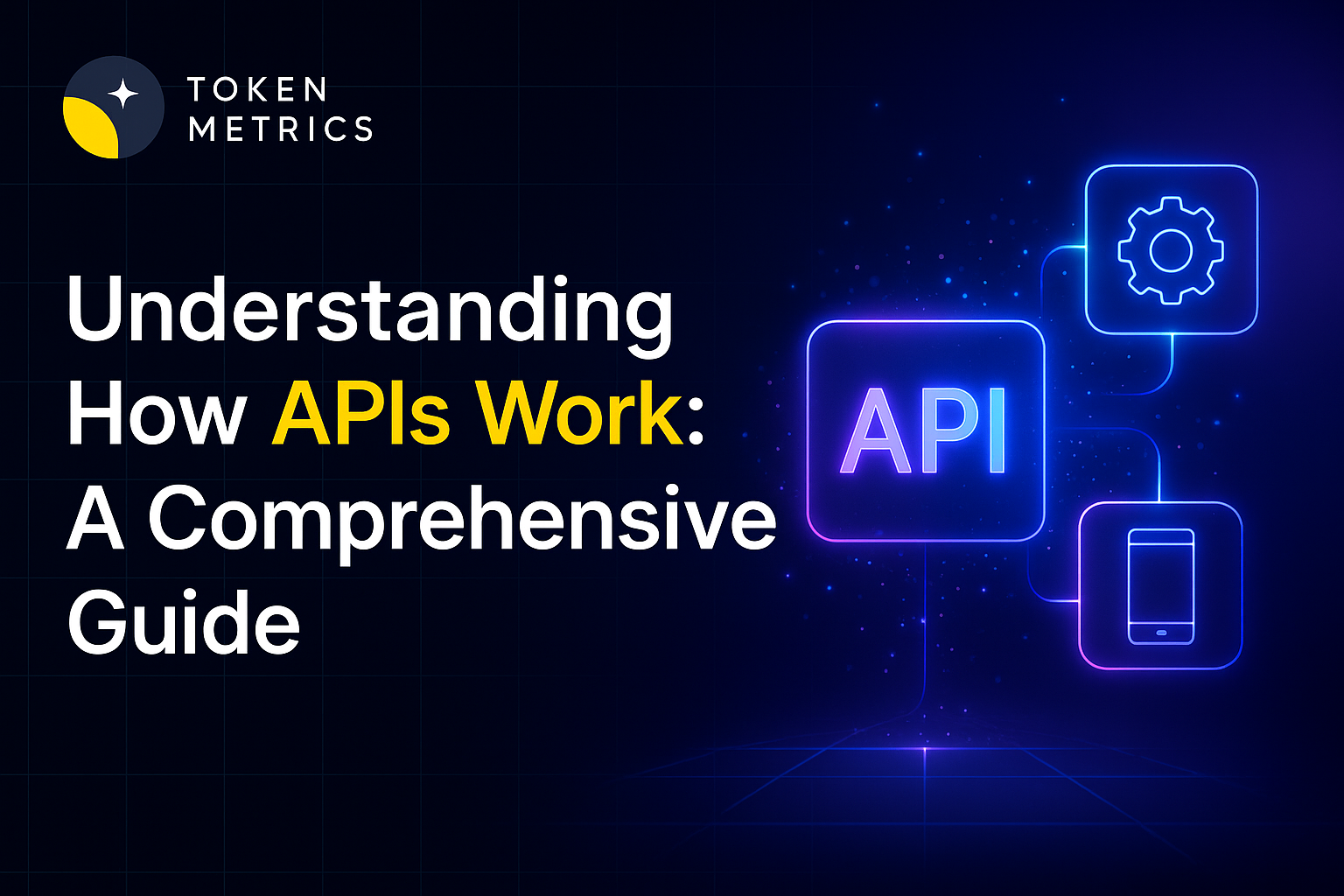
%201.svg)
%201.svg)
APIs, or Application Programming Interfaces, serve as essential tools in modern software development by allowing different applications to communicate and work together efficiently. Understanding how APIs work is fundamental for developers, businesses, and enthusiasts exploring technology or crypto environments where APIs facilitate seamless data exchange and integration.
An API is essentially a set of rules and protocols that enables different software applications to interact. It defines the methods and data formats that programs can use to request and exchange information. Through these interfaces, complex software systems can communicate without having to know the internal workings of each other, promoting modularity and efficiency.
APIs operate as intermediaries between client requests and server responses. When a user interacts with an application, the underlying API sends structured requests to a server which processes these requests and sends back the appropriate data or service. This process involves:
This exchange allows integration across services, such as connecting a mobile app to a database or enabling a crypto trading platform to access market data.
APIs are implemented using diverse standards and protocols depending on their purpose:
Understanding these protocols helps in selecting or designing the appropriate API solution for specific use cases.
In the cryptocurrency domain, APIs facilitate access to market data, trading functionalities, and analytics. Crypto APIs, including the Token Metrics API, provide developers and analysts with programmatic access to detailed metrics, historical data, and real-time updates.
Furthermore, AI-driven tools leverage APIs to gather and analyze vast datasets efficiently. Token Metrics, for example, integrates AI to enhance crypto research and analytics. Accessing this data programmatically via the Token Metrics API allows for automated strategies and custom insights without manual intervention.
To maximize the benefits of APIs, consider the following best practices:
For example, the best crypto API solutions often provide sandbox environments to allow safe experimentation with live-like data.
Crypto trading platforms utilize APIs to enable seamless order placements, market monitoring, and account management. Integrating APIs allows platforms to connect with external services or enable bots and third-party tools to interact with user accounts securely.
When exploring a crypto trading platform, understanding the underlying API capabilities helps users and developers gauge integration potential and automation possibilities.
The API ecosystem continues evolving with trends such as:
Monitoring developments through platforms like Token Metrics can keep users informed about innovations impacting crypto and tech sectors.
APIs are foundational in today's interconnected digital landscape, enabling diverse applications to communicate and unlock new functionalities efficiently. Recognizing how APIs work empowers users and developers to harness technology effectively across industries, particularly within crypto and AI-driven research contexts.
Utilizing APIs such as the Token Metrics API provides structured access to valuable data and analytics, fostering innovation and informed analysis.
This content is for educational purposes only and does not constitute financial or investment advice. Readers should conduct their own research and consult professionals as needed.
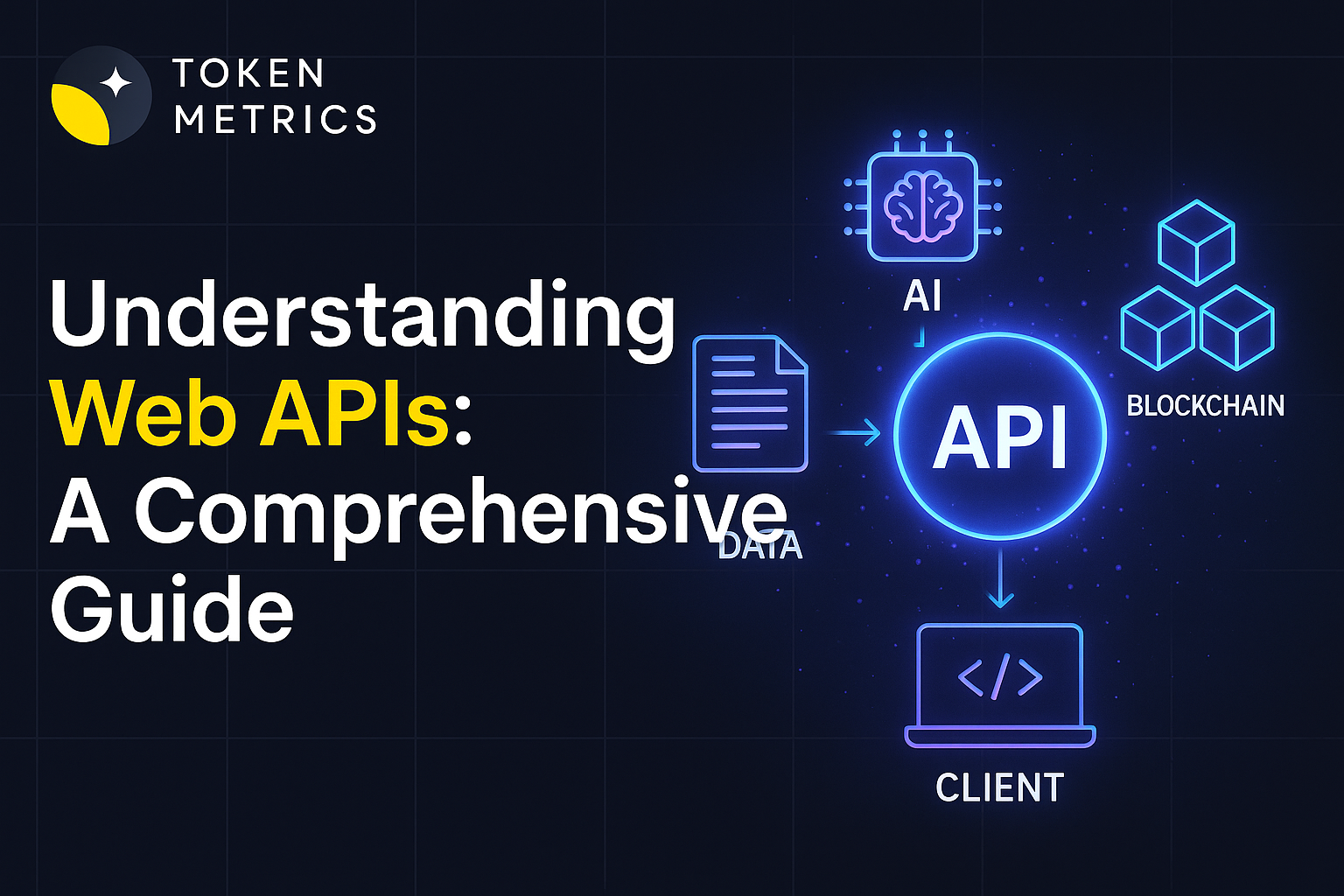
%201.svg)
%201.svg)
A Web API is an interface that allows different software applications to communicate with each other over the internet. Essentially, it is a set of protocols and tools for building and interacting with software applications remotely via the web. APIs enable developers to access specific functionalities or data from external services without having to understand the internal workings of those services.
Understanding the basic components of Web APIs helps clarify their importance in modern software development:
Web APIs function by receiving requests from clients and returning appropriate responses:
This request-response mechanism allows seamless integration between diverse systems and applications, facilitating interoperability and automation.
There are several types of Web APIs, each suited for different purposes:
Web APIs are foundational to many modern software ecosystems. They enable:
For example, the Token Metrics API provides a robust crypto API allowing seamless access to cryptocurrency data and metrics, supporting data-driven decision-making in crypto trading platforms.
Securing a Web API is crucial due to its exposure over the internet. Important measures include:
Leveraging Web APIs in software development brings multiple benefits:
Integrating AI and advanced data analytics with Web APIs can improve insights and user experiences. For instance, in the crypto domain, AI-driven platforms like Token Metrics utilize APIs to aggregate data and provide analytical ratings that inform research and trading strategies without offering financial advice.
By automating data retrieval via Token Metrics API and applying machine learning, businesses can unlock deeper insights while maintaining neutrality and compliance.
To effectively utilize Web APIs, consider these practical steps:
Web APIs are essential building blocks for modern digital applications, enabling diverse systems to communicate over the internet efficiently. Whether creating mobile apps, connecting to blockchain data via a crypto API, or integrating analytics platforms like Token Metrics, understanding Web APIs empowers developers and businesses to innovate responsively.
Adhering to best practices in design and security ensures APIs remain reliable and safe tools within the technology ecosystem.
This article is for educational and informational purposes only. It does not constitute investment advice, financial recommendations, or endorsements of any products or services. Readers should conduct their own research and consult professional advisors before making decisions related to cryptocurrency or technology investments.
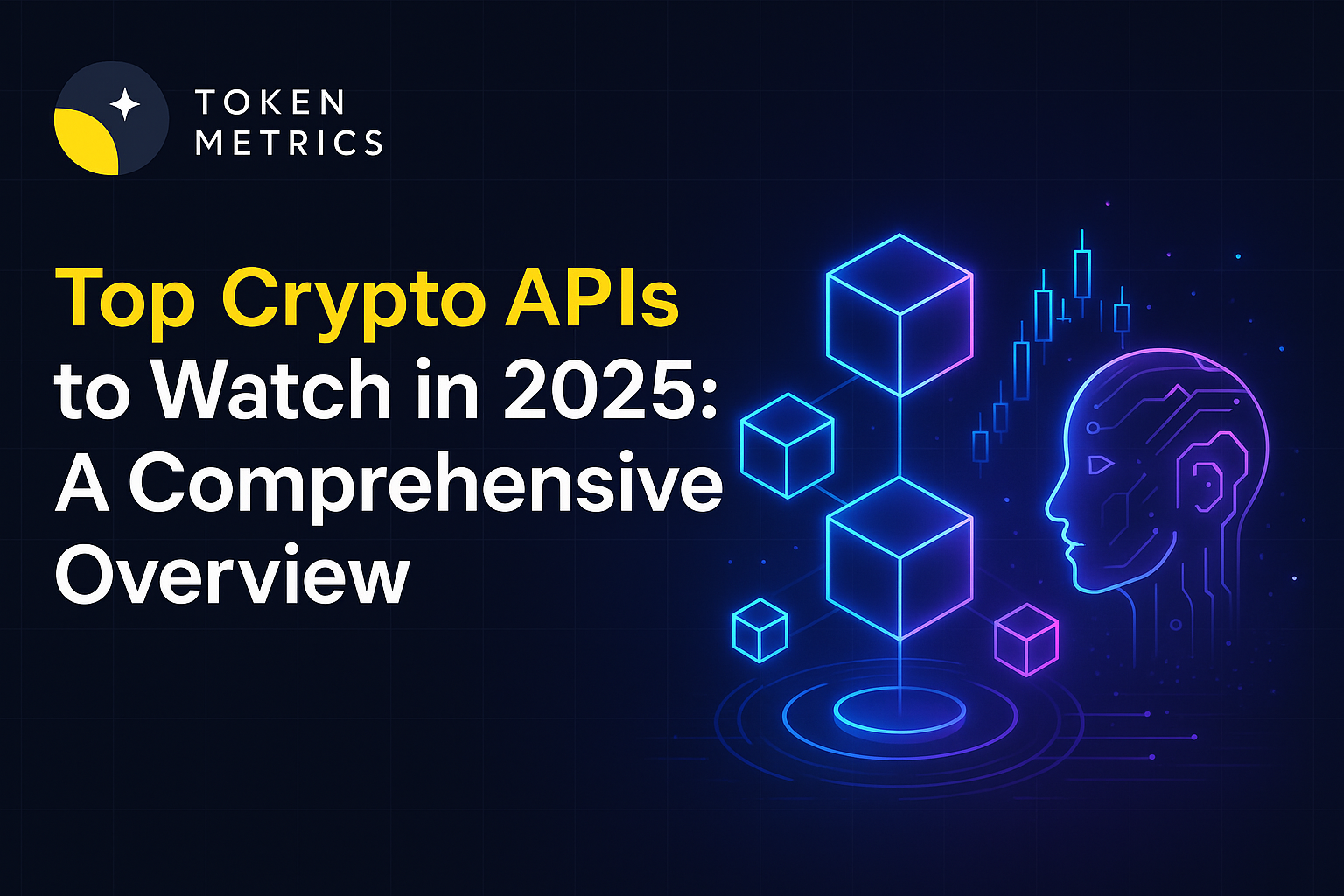
%201.svg)
%201.svg)
In the rapidly evolving cryptocurrency landscape, Access to reliable and comprehensive APIs has become essential for developers, analysts, and businesses aiming to integrate blockchain data or build crypto-focused applications. As we approach 2025, understanding which APIs offer robust features, extensive data coverage, and advanced analytical capabilities is critical to making informed technology choices. This post provides an analytical overview of the best crypto APIs available in 2025, focusing on technical features, data reliability, and integration possibilities.
A crypto API is an application programming interface that facilitates access to cryptocurrency data and services. It typically provides endpoints to retrieve market data, historical prices, blockchain statistics, transaction data, order book snapshots, and other relevant crypto metrics. Developers and analysts use these APIs to collect data for research, build trading bots, track portfolio performance, or power analytics platforms.
In 2025, crypto APIs increasingly integrate AI-enhanced analytics and machine learning capabilities to offer predictive insights and streamline data interpretation.
Choosing the best crypto API involves multiple factors that influence usability and effectiveness:
Among many providers, some stand out based on these criteria.
AI integration in crypto APIs represents a significant advancement heading into 2025. Providers like the Token Metrics API enhance raw data with predictive models and rating systems that help developers and analysts prioritize research focus. AI can automate pattern recognition, detect anomalies, and estimate potential impacts of market factors from vast datasets.
This additional layer moves crypto APIs beyond simple data delivery toward becoming comprehensive research tools, improving operational efficiency for platforms dealing with big data.
When employing a crypto API, consider the following best practices:
Modern crypto trading platforms rely heavily on APIs for market data and trade execution. For instance, Token Metrics offers tools that integrate with various APIs to provide an enhanced user experience, combining data analytics with trading functionalities.
Choosing APIs that support trading-related features, such as order placement and balance checks, alongside data retrieval, is beneficial for building seamless crypto trading platforms.
When utilizing crypto APIs, keep these points in mind:
In 2025, the best crypto APIs will be those that combine extensive data coverage with advanced analytical capabilities. The integration of AI, as exemplified by the Token Metrics API, sets a new standard for developers and researchers aiming for deeper insights. While data quality and reliability remain paramount, the ongoing refinement of crypto APIs will likely focus on enhancing user control, predictive analysis, and ease of integration.
Exploring APIs with a critical, research-oriented approach remains essential for anyone harnessing crypto data, and tools like Token Metrics demonstrate how combining market data with AI can support comprehensive crypto ecosystems.
This blog post is intended for educational purposes only and does not constitute financial advice, investment recommendations, or solicitations. Always conduct your own research and consult with professional advisers before making any financial decisions related to cryptocurrencies.


 Create Your Free Account
Create Your Free Account9450 SW Gemini Dr
PMB 59348
Beaverton, Oregon 97008-7105 US
.svg)




.png)
Token Metrics Media LLC is a regular publication of information, analysis, and commentary focused especially on blockchain technology and business, cryptocurrency, blockchain-based tokens, market trends, and trading strategies.
Token Metrics Media LLC does not provide individually tailored investment advice and does not take a subscriber’s or anyone’s personal circumstances into consideration when discussing investments; nor is Token Metrics Advisers LLC registered as an investment adviser or broker-dealer in any jurisdiction.
Information contained herein is not an offer or solicitation to buy, hold, or sell any security. The Token Metrics team has advised and invested in many blockchain companies. A complete list of their advisory roles and current holdings can be viewed here: https://tokenmetrics.com/disclosures.html/
Token Metrics Media LLC relies on information from various sources believed to be reliable, including clients and third parties, but cannot guarantee the accuracy and completeness of that information. Additionally, Token Metrics Media LLC does not provide tax advice, and investors are encouraged to consult with their personal tax advisors.
All investing involves risk, including the possible loss of money you invest, and past performance does not guarantee future performance. Ratings and price predictions are provided for informational and illustrative purposes, and may not reflect actual future performance.

